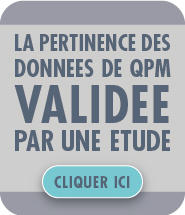The QPM® process is based on measurement of the electrical conductivity of the organism.
This electrical measurement Is done with 6 electrodes in contact with the skin.
The information returned by alternating micro-currents, having no secondary effects sent to these enable the system to record 30 branches of the organism.
By cross-analysis, the computer locates the areas of lesser or greater conductivity.
Why perform a bio-electrical mapping of the individual ?
It has been known for a long time now that the nervous system is above all a bio-electrical system. It is that bio-electricity that enables us to precisely characterize its operation, through an electro-encephalogram.
When electrons (or ions) traverse a system, the activity of that system depends also on the circuits followed, and their specific characteristics. Hence, conductivity, or conversely the resistivity and impedance of some areas of the body, are crucial measurements.
Measurement of these attributes enables a bio-electronic mapping of the entire organism. The neuro-mediators and hormones released by the brain have a considerable impact on that mapping.
The QPM® process is based on the production of an electronic map of the individual, a dynamic map that fluctuates according to the subject’s condition at the time of measurement. As with any order of magnitude associated with a living system, it consists in a variety of components, some that change over time, and others that we consider invariable, because they are stable.
It would be wrong to consider these components (which are unique to each individual) merely the result of happenstance. On the contrary, experience shows that they are particularly dependent and representative of our physical and mental condition.
In this context, the analysis of the afore-mentioned variables and the precise identification of the invariables provide indications as to the individual’s bio-electronic functioning.
The first step in the QPM® process consists of measuring and recording those bio-electrical orders of magnitude using the appropriate equipment and a computer.
Bases for the interpretation.
Once recorded, these data are processed using software that will transpose their values into an analysis and interpretation table.
The resulting readout (in table form) is the fruit of extensive compilation work in reference to previously existing systems, as well as to a large number of tests performed by well qualified experimental technicians with longstanding experience in the field.
Therefore, independently of the care taken with the initial measurements, the interpretation software constantly improves and becomes increasingly reliable, thanks to daily input of our QPM® partners.
Within the framework of those partnerships, the QPM®, confronting the specific features of different fields, progresses and can be tailored to new applications.





